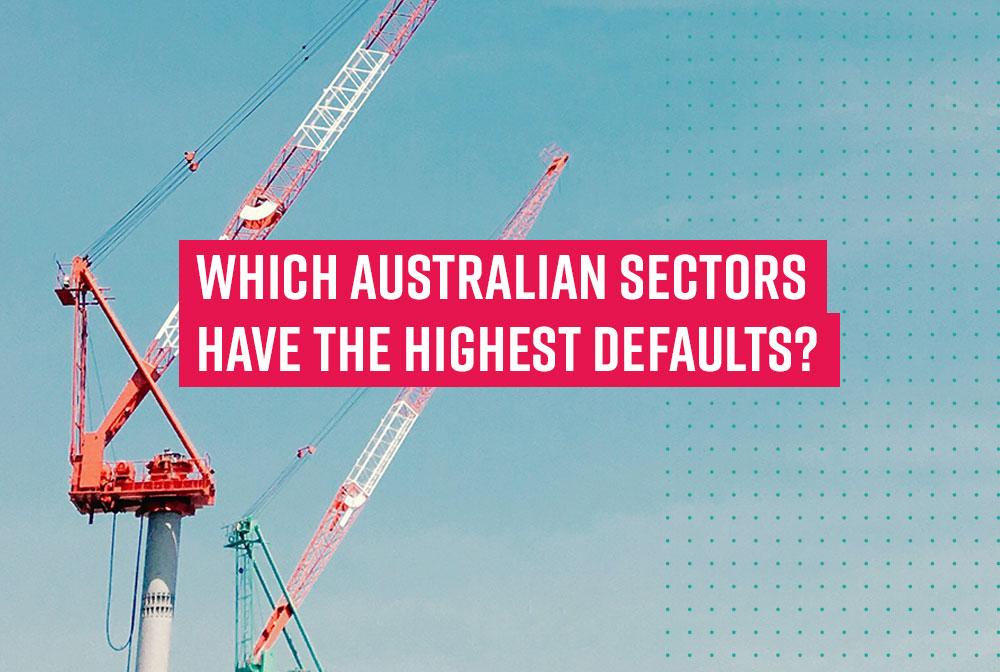Companies That Fail: What the Latest ASIC Statistics Reveal
Retail trade and construction are among the industry sectors to experience an increase in insolvencies, according to the latest statistics* released by the Australian Securities and Investment Commission (ASIC) for the first quarter of 2019.

According to the statistics, of the 8,048 Australian companies that experienced external administration (EXAD) in the 12 months ended March 2019, three-quarters of these defaults came from one of these four major industry sectors:
- Business and personal services
- Construction
- Accommodation and food services
- Retail trade
Each of these sectors has experienced an increase in defaults over the last twelve months, with the most notable uplifts coming from accommodation and food services, where defaults have leapt by 11% over the previous 12 months; as well as retail trade which ran a close second with a 10% increase in defaults.
While the construction sector was observed to have a 5% uplift in defaults over the same period, business and personal services defaults rose by only 1%.
Other sectors experiencing an increase in EXADs over the last twelve months include:
- Wholesale trade (up 11%)
- Rental, hiring & real estate services (up 21%)
- Electricity, gas, water & waste services (up 17%)
- Information, media & telecommunications (up 7%)
- Administrative & support services (up 34%)
Why are some Australian sectors struggling more than others?
Head of Product and Rating Services at Equifax, Brad Walters, said the statistics reveal some interesting insights into the factors behind these defaults.
“Construction is one of the sectors that has recently experienced a material increase in defaults, rising 21% over the last six months relative to the comparable period in the preceding year. This is especially evident in the eastern seaboard, and this quarter saw a 32% increase in defaults in NSW, a 16% increase in Victoria and a 20% increase in Queensland compared with the same quarter last year,” Walters said.
“Residential building activity has been declining, with the fall in house prices and deteriorating market conditions impacting the sector. Dwelling approvals are down 24% year-on-year. While non-residential building has strengthened, this is not enough to offset the overall impact, and public engineering construction has contracted for the third consecutive quarter.”
The increase in defaults in the retail sector is also no surprise. “There has been a shift in household spending from retail, which has been exacerbated by rising prices of health, education and utilities. This quarter, as well as the year-on-year comparison, reflects the lowest growth in real retail sales for a long time, and has led to more retailers struggling to stay afloat,” explains Walters.
ASIC statistics nominate the top five causes of business failure^ as:
- Inadequate cash flow
- Poor strategic management of business
- Trading losses
- Poor financial control
- Under capitalisation
Which Australian sectors have reduced their defaults?
According to ASIC’s statistics, the manufacturing and mining sectors continue to report decreases in defaults, with a 13% reduction in manufacturing defaults and a 6% reduction in mining defaults in the past 12 months.
Another good news story is the professional and technical services sector that has experienced a 5% reduction in defaults over the last 12 months. A large and diverse industry that includes activities such as legal, accounting and veterinary services, there appears to be a level of resilience in this higher skilled sector of the market compared with other business and personal services, or administrative and support services.
Did you know?
- While the majority of defaults relate to micro or small/home office businesses, 35% of all EXAD reports relate to businesses that have more than five (5) full-time equivalent (FTE) employees[i]
- 38% of all EXAD reports showed an estimated total deficiency of more than $500k[ii]
- 38% of all EXAD reports had more than $250k owed to unsecured creditors[iii]
- 97% of unsecured creditors receive less than 11 cents in the dollar[iv]
- 85%+ of the causes of business failure relate to financial or other factors that would be expected to be routinely identified within a Credit Rating Report[v]
What we know about companies that fail
“Companies don’t fail overnight; the early warning signs are there if you know what to look for,” Walters says.
“We know that when managers are looking to make important decisions about the viability and capacity of key counterparties, it’s invaluable for them to have access to the right financial insights and predictive analytics across their customers, partners and suppliers.
“Financial statement analysis has been shown to provide more than a 40%[vi] uplift in predicting default on non-micro businesses – in other words, for businesses with sales revenue above five million.”
Considering many of the drivers of EXAD are financial, the ASIC statistics provide a warning bell to companies about the critical role financial insights can play in effective risk management.
* Source: Australian insolvency statistics (Released: May 2019), Series 1A: Companies entering external administration by industry, July 2013–March 2019. ^Source: ASIC, Australian insolvency statistics (November 2018), Table 3.1.3.1 - Initial external administrators' reports—Nominated causes of failure by industry (1 July 2017–30 June 2018)
[i] Australian insolvency statistics (Released: Nov 2018), 3.1 - External administrators' reports for Australia, 1 July 2017–30 June 2018, Table 3.1.2.1 - Initial external administrators' reports—Size of company as measured by number of FTEs by industry (1 July 2017–30 June 2018)
[ii] Australian insolvency statistics (Released: Nov 2018), 3.1 - External administrators' reports for Australia, 1 July 2017–30 June 2018, Table 3.1.5.1 - Initial external administrators' reports—Assets, liabilities and deficiency by industry (1 July 2017–30 June 2018)
[iii] Australian insolvency statistics (Released: Nov 2018), 3.1 - External administrators' reports for Australia, 1 July 2017–30 June 2018, Table 3.1.9.1 - Initial external administrators' reports—Unsecured creditors by industry (1 July 2017–30 June 2018)
[iv] Australian insolvency statistics (Released: Nov 2018), 3.1 - External administrators' reports for Australia, 1 July 2017–30 June 2018, Table 3.1.9.1 - Initial external administrators' reports—Unsecured creditors by industry (1 July 2017–30 June 2018)
[v] Equifax, and Australian insolvency statistics (Released: Nov 2018), 3.1 - External administrators' reports for Australia, 1 July 2017–30 June 2018, Table 3.1.3.1 - Initial external administrators' reports—Nominated causes of failure by industry (1 July 2017–30 June 2018)
[vi] Equifax analysis using 10k financial statements, commercial bureau and trade payment data


